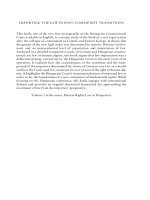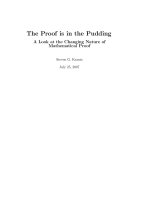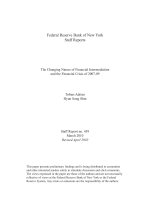Changing Nature Of Financial Intermediation And The Financial Crisis Of 2007-09 pptx
Bạn đang xem bản rút gọn của tài liệu. Xem và tải ngay bản đầy đủ của tài liệu tại đây (618.87 KB, 35 trang )
Federal Reserve Bank of New York
Staff Reports
The Changing Nature of Financial Intermediation
and the Financial Crisis of 2007-09
Tobias Adrian
Hyun Song Shin
Staff Report no. 439
March 2010
Revised April 2010
This paper presents preliminary findings and is being distributed to economists
and other interested readers solely to stimulate discussion and elicit comments.
The views expressed in the paper are those of the authors and are not necessarily
reflective of views at the Federal Reserve Bank of New York or the Federal
Reserve System. Any errors or omissions are the responsibility of the authors.
The Changing Nature of Financial Intermediation and the Financial Crisis of 2007-09
Tobias Adrian and Hyun Song Shin
Federal Reserve Bank of New York Staff Reports, no. 439
March 2010; revised April 2010
JEL classification: E02, E58, G10, G18
Abstract
The financial crisis of 2007-09 highlighted the changing role of financial institutions
and the growing importance of the “shadow banking system,” which grew out of the
securitization of assets and the integration of banking with capital market developments.
This trend was most pronounced in the United States, but it also had a profound influence
on the global financial system as a whole. In a market-based financial system, banking
and capital market developments are inseparable, and funding conditions are tied closely
to fluctuations in the leverage of market-based financial intermediaries. Balance-sheet
growth of market-based financial intermediaries provides a window on liquidity by
indicating the availability of credit, while contractions of balance sheets have tended
to precede the onset of financial crises. We describe the changing nature of financial
intermediation in the market-based financial system, chart the course of the recent
financial crisis, and outline the policy responses that have been implemented by the
Federal Reserve and other central banks.
Key words: financial crisis, financial intermediation, intermediation chains,
procyclicality, liquidity facilities, monetary polic
Adrian: Federal Reserve Bank of New York (e-mail: ). Shin: Princeton
University (e-mail: ). This paper was prepared for the Annual Review of
Economics. The views expressed in this paper are those of the authors and do not necessarily
reflect the position of the Federal Reserve Bank of New York or the Federal Reserve System.
Page 1 of 34
INTRODUCTION
The financial system channels savings from investors to those who need funding—i.e., from
ultimate lenders to ultimate borrowers. The ultimate lenders are households and institutions such
as pension fund, mutual fund, and life insurance companies that invest on behalf of households.
Some credit will be provided directly from the lender to the borrower, as is the case with
Treasury securities, municipal bonds, and corporate bonds. However, the bulk of the credit
financing in the economy is intermediated through the banking system, interpreted broadly.
Understanding the workings of financial intermediation and the way in which the banking
system has evolved over the past several decades is crucial for understanding the global financial
crisis that erupted in 2007 and for formulating policy—both short-term crisis management
policies as well as long-term policies for building a more resilient financial system.
Figure 1 is a stylized depiction of the financial system that channels funds from ultimate
lenders to ultimate borrowers. For the household sector, borrowing is almost always
intermediated through the banking system, broadly defined. At the end of 2008, U.S. household-
sector mortgage liabilities amounted to approximately $10.6 trillion, and consumer debt accounts
amounted to another $2.5 trillion.
Figure 1. Stylized Financial System
In the traditional model of financial intermediation, a bank takes in retail deposits from
household savers and lends out the proceeds to borrowers such as firms or other households.
Figure 2 (see color insert) depicts the archetypal intermediation function performed by a bank;
in this case, the bank channels household deposits to younger households who need to borrow to
Page 2 of 34
buy a house. Indeed, until recently, the financial intermediation depicted in Figure 2 was the
norm, and the bulk of home mortgage lending in the United States was conducted in this way.
Figure 2. Short Intermediation Chain
households
mortgage bank households
deposits
mortgage
However, the U.S. financial system underwent a far-reaching transformation in the 1980s
with the takeoff of securitization in the residential mortgage market. Figure 3 charts the total
dollar value of residential mortgage assets held by different classes of financial institutions in the
United States, as taken from the Federal Reserve’s Flow of Funds accounts.
Figure 3. Total Holdings of US Home Mortgages by Type of Financial Institution
(Source: US Flow of Funds, Federal Reserve, 1980-2009)
0.0
1.0
2.0
3.0
4.0
5.0
6.0
0.0
1.0
2.0
3.0
4.0
5.0
6.0
1980
1985
1990
1995
2000
2005
$ Trillions
Agency and GSE mortgage pools
ABS issuers
Savings institutions
GSEs
Credit unions
Commercial Banks
Until the early 1980s, banks and savings institutions (such as the regional savings and
loans) were the dominant holders of home mortgages. However, with the emergence of
securitization, banks sold their mortgage assets to institutions that financed these purchases by
issuing mortgage-backed securities (MBSs). In particular, the GSE (government-sponsored
enterprise) mortgage pools became the dominant holders of residential mortgage assets. In
Figure 4 (see color insert), bank-based holdings comprise the holdings of commercial banks,
savings institutions, and credit unions. Market-based holdings are the remainder—i.e., the GSE
mortgage pools, private-label mortgage pools, and the GSE holdings themselves. Market-based
holdings now constitute two-thirds of the $11 trillion total of home mortgages.
Page 3 of 34
Figure 4. Market Based and Bank Based Holding of Home Mortgages
(Source: US Flow of Funds, Federal Reserve, 1980-2009)
0
2
4
6
8
0
2
4
6
8
1980
1985
1990
1995
2000
2005
$ Trillions
Bank-based
Market-based
Although residential mortgages have been the most important element in the evolution of
securitization, the growing importance of market-based financial intermediaries is a more general
phenomenon that extends to other forms of lending—including consumer loans such as those for
credit card and automobile purchases, as well as commercial real estate or corporate loans. The
growing weight of the financial intermediaries that operate in the capital markets can be seen in
Figure 5, which compares total assets held by banks with the assets of securitization pools and
those held by institutions that fund themselves mainly by issuing securities. By the end of the
second quarter of 2007 (just before the crisis began), the assets of this latter group (i.e., total
market-based assets) were larger than the total assets on banks’ balance sheets.
Figure 5. Total Assets at 2007Q2 (Source: US Flow of Funds, Federal Reserve)
ABS Issuers
4.5
Credit Unions 0.7
Broker Dealers
3.2
Savings Inst.
1.8
Finance Co. 1.9
Commercial Banks
10.5
GSE
Mortgage
Pools
4.1
GSE
2.9
0.0
2.0
4.0
6.0
8.0
10.0
12.0
14.0
16.0
18.0
Market-based
Bank-based
$ Trillion
Page 4 of 34
As the financial system has changed, so has the mode of financial intermediation. A
characteristic feature of financial intermediation that operates through the capital market is the
long chain of financial intermediaries involved in channeling funds from the ultimate creditors to
the ultimate borrowers. Figure 6 illustrates one possible chain of lending relationships in a
market-based financial system, whereby credit flows from the ultimate creditors (household
savers) to the ultimate debtors (households who obtain a mortgage to buy a house).
Figure 6. Long Intermediation Chain
households households
ABS
mortgage
securities firm
commercial bank
money market fund
ABS issuer
mortgage pool
MBS
Repo
Short-term
paper
MMF shares
In this illustration, mortgages are originated by financial institutions such as banks that
sell individual mortgages into a mortgage pool such as a conduit. The mortgage pool is a passive
firm (sometimes called a warehouse) whose only role is to hold mortgage assets. The mortgage is
then packaged into another pool of mortgages to form MBSs, which are liabilities issued against
the mortgage assets. The MBSs might then be owned by an asset-backed security (ABS) issuer
who pools and tranches them into another layer of claims, such as collateralized debt obligations.
A securities firm (e.g., a Wall Street investment bank) might hold collateralized debt obligations
on its own books for their yield but will finance such assets by collateralized borrowing through
repurchase agreements (i.e., repos) with a larger commercial bank. In turn, the commercial bank
would fund its lending to the securities firm by issuing short-term liabilities, such as financial
commercial paper. Money market mutual funds would be natural buyers of such short-term
paper, and, ultimately, the money market fund would complete the circle as household savers
would own shares of these funds.
Figure 6 illustrates that those institutions involved in the intermediation chain were
precisely those that were at the sharp end of the financial crisis that erupted in 2007. As subprime
Page 5 of 34
mortgages cropped up in this chain and disrupted its smooth functioning, we witnessed both the
near-failures of Bear Stearns and Merrill Lynch, as well as the failure of Lehman Brothers. This
realization pushes us to dig deeper into the role of such market-based financial intermediaries in
the modern financial system.
The answers are revealing. In a market-based financial system, banking and capital
market developments are inseparable, and fluctuations in financial conditions have a far-reaching
impact on the workings of the real economy. We see in the discussion that follows precisely how
capital market conditions influence financial intermediation.
MARKET-BASED FINANCIAL INTERMEDIARIES
The increased importance of the market-based banking system has been mirrored by the growth
(and subsequent collapse) of the broker-dealer sector of the economy, the sector that includes the
securities firms. Broker-dealers are at the heart of the market-based financial system, as they
make markets for tradable assets, they originate new securities, and they produce derivatives.
Broker-dealers thus mirror the overall evolution of the market-based financial system.
Although broker-dealers have traditionally played market-making and underwriting roles
in securities markets, their importance in the supply of credit has increased in step with
securitization. Thus, although the size of total broker-dealer assets is small in comparison to the
commercial banking sector (at its peak, it was approximately only one-third of the commercial
bank sector), broker-dealers became a better barometer for overall funding conditions in a
market-based financial system.
The astonishing growth of the securities sector can be seen in Figure 7, which charts the
growth of four sectors in the United States: the household sector, the nonfinancial corporate
sector, the commercial banking sector, and the security broker-dealer sector. All series have been
normalized to 1 for March 1954. Whereas the first three sectors had grown roughly 80-fold since
1954, the securities sector had grown roughly 800-fold before collapsing in the crisis.
Page 6 of 34
Figure 7: Growth of Assets of Four Sectors in the United States (March 1954 = 1)
(Source: US Flow of Funds, Federal Reserve, 1980-2009)
0
100
200
300
400
500
600
700
800
900
1954
1964
1974
1984
1994
2004
Non-financial
corporate
Households
Security Broker
Dealers
Commercial Banks
Figure 8 contains the same series depicted in Figure 7, but with the vertical axis
expressed in log scale. We see from Figure 8 that the rapid increase in the securities sector
began around 1980, coincident with the takeoff in the securitization of residential mortgages.
Figure 8: Growth of Assets of Four Sectors in the United States (March 1954 = 1)
(Log scale) (Source: Federal Reserve, Flow of Funds, 1954-2009)
1
10
100
1000
1954
1964
1974
1984
1994
2004
Non-financial
corporate
Households
Security Broker
Dealers
Commercial Banks
1980Q1
At the margin, all financial intermediaries (including commercial banks) have to borrow
in capital markets, as deposits are insufficient to meet funding needs. The large balance sheets of
commercial banks, however, mask the effects operating at the margin. In contrast, securities
firms have balance sheets that are much more sensitive to the effects operating in the financial
markets. As an illustration, Figure 9 summarizes the balance sheet of Lehman Brothers at the
end of the 2007 financial year, when total assets were $691 billion.
Page 7 of 34
Figure 9. Balance Sheet Composition of Lehman Brothers, End 2007
Cash
1%
Long position
45%
Collateralized
lending
44%
Receivables
6%
Other
4%
Short term
debt
8%
Short position
22%
Collateralized
borrowing
37%
Payables
12%
Long-term
debt
18%
Equity
3%
Assets
Liabilities
The two largest classes of assets were (a) long positions in trading assets and other
financial inventories and (b) collateralized lending. The collateralized lending reflected
Lehman’s role as a prime broker to hedge funds and consisted of reverse repos in addition to
other types of collateralized lending. Much of this collateralized lending was short term, often
overnight. The other feature of the asset side of the balance sheet is how small the cash holdings
were; out of a total balance-sheet size of $691 billion, cash holdings amounted to only $7.29
billion.
Much of the liabilities of Lehman Brothers was of a short-term nature. The largest
component was collateralized borrowing, including repos. Short positions (financial instruments
and other inventory positions sold but not yet purchased) were the next largest component. Long-
term debt was only 18% of total liabilities. One notable item is the payables category, which was
12% of the total balance-sheet size. Payables included the cash deposits of Lehman’s customers,
especially its hedge-fund clientele. It is for this reason that payables are much larger than
receivables, which were only 6%, on the asset side of the balance sheet. Hedge-fund customers’
deposits are subject to withdrawal on demand and proved to be an important source of funding
instability.
In this way, broker-dealers have balance sheets that are short term and, thus, highly
attuned to fluctuations in market conditions. The ultimate supply of securitized credit to the real
economy is often channeled through broker-dealer balance sheets. As such, they serve as a
barometer of overall funding conditions in a market-based financial system.
Page 8 of 34
The growing importance of securities firms as a mirror of overall capital market
conditions can be seen from the aggregate balance-sheet quantities in the economy (see Adrian
and Shin (2009b). Figure 10 compares the stock of repos of U.S. primary dealers
1
plus the stock
of financial commercial paper expressed as a proportion of the M2 money stock. M2 includes the
bulk of retail deposits and holdings in money market mutual funds and, thus, is a good proxy for
the total stock of liquid claims held by ultimate creditors against the financial intermediary sector
as a whole. As recently as the early 1990s, repos and financial commercial paper were only one-
quarter the size of M2. However, their combined total rose rapidly and reached over 80% of M2
by August 2007, only to collapse with the onset of the financial crisis.
Figure 10. Repos and Financial CP as Proportion of M2
(Source: US Flow of Funds, Federal Reserve, 1990W1-2010W5)
20%
30%
40%
50%
60%
70%
80%
90%
1990
1994
1998
2002
2006
Aug 12 1998
Sep 12 2001
Aug 8 2007
Se p 10 2008
Jan 4 2010
The ultra-short nature of financial intermediaries’ obligations to each other can be better
seen by plotting the component of the overall repo series consisting only of overnight repos.
Figure 11 plots the size of the overnight repo stock, financial commercial paper, and M2, all
normalized to equal 1 on July 6th, 1994 (the data on overnight repos are not available before that
date). The stock of M2 has grown by a factor of over 2.4 since 1994, but the stock of overnight
repos had grown almost sevenfold up to March 2008. Brunnermeier (2009) has noted that the use
of overnight repos became so prevalent that, at its peak, the Wall Street investment banks were
rolling over one-quarter of their balance sheets every night.
Page 9 of 34
Figure 11. Overnight Repos and M2
(Source: Federal Reserve, 1994W1-2010W5)
0.0
1.0
2.0
3.0
4.0
5.0
6.0
7.0
8.0
1994
1997
2000
2003
2006
2009
Overnight Repo
Financial CP
M2
Mar 19 2008
Dec 28 2009
Aug 8
2007
2.43
LIQUIDITY AND LEVERAGE
Much more important than the sheer size of the securities sector, however, is the behavior of the
market-based intermediaries themselves and how they react to shifts in market conditions. We
can pose the question in terms of how market-based intermediaries manage their balance sheets
and, in particular, how leverage and balance-sheet size are related.
Leverage is the ratio of total assets to equity. For households, leverage is inversely related
to total assets. For example, when households buy a house with a mortgage, their net worth
increases at a faster rate than total assets as housing prices rise, leading to a fall in leverage.
The negative relationship between total household assets and leverage is clearly borne out
in the aggregate data. Figure 12 plots the quarterly changes in total assets versus the quarterly
changes in leverage as given in the Flow of Funds accounts for the United States, as taken from
Adrian & Shin (2007). The scatter chart shows a strongly negative relationship, as suggested by
a passive behavior toward asset price changes.
Page 10 of 34
Figure 12. Household Sector Leverage and Total Assets
(Source: U.S. Flow of Funds, Federal Reserve, 1963-2007)
-4
-2
0
2
4
6
8
-1
-0.5
0
0.5
1
1.5
Leverage Growth (Percent Quarterly)
Total Asset Growth (Percent Quarterly)
Figure 13 (see color insert) is a similar scatter chart of the change in leverage and change
in total assets for nonfinancial, nonfarm corporations drawn from the U.S. Flow of Funds. The
scatter chart shows a much weaker negative pattern, suggesting that companies react only
somewhat to changes in asset prices by shifting their stance on leverage.
Figure 13. Non-financial corporate sector leverage and total assets
(Source: U.S. Flow of Funds, Federal Reserve, 1963-2007)
-2
-1
0
1
2
3
4
5
6
-2.5 -2 -1.5 -1 -0.5 0 0.5 1 1.5 2 2.5
Leverage Growth (Percent Quarterly)
Total Assets Growth (Percent Quarterly)
Figure 14 is the corresponding scatter chart for U.S. security dealers and brokers. The
alignment of the observations is now the reverse of that for households. There is a strongly
positive relationship between changes in total assets and changes in leverage. In this sense,
leverage is procyclical.
Page 11 of 34
Figure 14. Broker Dealer Sector Leverage and Total Assets
(Source: U.S. Flow of Funds, Federal Reserve, 1963-2007)
-30
-20
-10
0
10
20
30
40
-50 -40 -30 -20 -10 0 10 20 30 40
Leverage Growth (Percent Quarterly)
Total Asset Growth (Percent Quarterly)
Figure 15. US Investment Banks' Leverage and Total Assets
(Source SEC; Adrian and Shin (2007), updated)
2008q2
2008q3
2007q3
2007q4
2008q1
1998q4
2 1 0
.1 .2
Total Asset Growth
2 1
0 .1 .2
Leverage Growth
Lehman Brothers
1987q4
1998q4
2007q3
2008q2
2008q3
2007q4
2008q1
2
1 0
.1 .2
Total Asset Growth
2 1 0 .1
.2
Leverage Growth
Merrill Lynch
1987q4
2008q3
2007q3
2007q4
2008q1
2008q2
2008q4
1998q4
3
2 1
0 .1
.2
Total Asset Growth
6 4 2 0 .2
Leverage Growth
Morgan Stanley
1987q4
2007q3
2007q4
2008q1
1998q4
4
2 0
.2 .4
Total Asset Growth
4 2 0 .2 .4
Leverage Growth
Bear Stearns
2008q2
2008q3
2008q4
2007q3
2007q4
2008q1
2
1
0 .1
Total Asset Growth
4 3 2 1 0 .1
Leverage Growth
Goldman Sachs
1998q3
1998q4
2 1 0
.1 .2
Total Asset Growth
2 1 0 .1 .2
Leverage Growth
Citigroup Markets, 98-04
Total Assets and Leverage
The procyclical nature of leverage is evident for individual firms, too, as seen in Figure
15, which gives the scatter plots for quarterly growth in leverage and total assets of what were, at
the time, the five stand-alone U.S. investment banks (Bear Stearns, Goldman Sachs, Lehman
Page 12 of 34
Brothers, Merrill Lynch, and Morgan Stanley) together with Citigroup Global Markets (1998Q1–
2004Q4). In all cases, leverage is large when total assets are large—i.e., leverage is procyclical.
Figure 16 shows the scatter chart of the weighted average of the quarterly change in assets
against the quarterly change in leverage of the five investment banks.
Figure 16. Leverage Growth and Asset Growth of US Investment Banks
(Source SEC; Adrian and Shin (2007), updated)
1987q4
2007q3
2007q4
2008q3
2008q4
1998q4
2008q1
2008q2
-20 -10 0 10
20
Total Asset Growth
-40 -20
0 20
Leverage Growth
We can confirm from these figures the striking feature that leverage is procyclical in the
sense that leverage grows when balance sheets are growing and then contracts when balance
sheets are contracting. This is exactly the opposite finding for households, whose leverage rises
when balance sheets contract.
Procyclical leverage offers a window into financial system liquidity. The horizontal axis
of Figure 16 measures the (quarterly) growth in leverage, as measured by the change in log
assets minus the change in log equity. The vertical axis measures the change in log assets.
Hence, the 45-degree line indicates the set of points at which (log) equity is unchanged. In other
words, the 45-degree line indicates the set of points at which equity is unchanged from one
period to the next.
Page 13 of 34
Above the 45-degree line, equity is increasing while equity is decreasing below it. The
distance from the 45-degree line indicates the growth of equity from one period to the next.
Thus, any straight line parallel to the 45-degree line indicates the set of points at which the
growth of equity is equal. In other words, any straight line with a slope equal to 1 indicates
constant growth of equity, with the intercept giving the growth rate of equity. We see that the
realizations in the scatter plot in Figure 16 are clustered around a straight line with a slope
roughly equal to 1, suggesting that a useful first approximation of the data is that equity is
increasing at a constant rate on average, with total assets determined by the allowable leverage
ruling at that date.
In this way, equity appears to play the role of the forcing variable, and the adjustment in
leverage primarily takes place through expansions and contractions of the balance sheet rather
than through the raising or paying out of equity. We can understand the fluctuations in leverage
in terms of the implicit maximum leverage permitted by creditors in collateralized borrowing
transactions such as repos. In a repo, the borrower sells a security today for below the current
market price on the understanding that it will buy it back in the future at a pre-agreed price. The
difference between the current market price of the security and the price at which it is sold is
called the haircut in the repo. The fluctuations in the haircut largely determine the degree of
funding available to a leveraged institution, as the haircut determines the maximum permissible
leverage achieved by the borrower. For example, if the haircut is 2%, the borrower can borrow
$98 for every $100 worth of securities pledged; i.e., to hold $100 worth of securities, the
borrower must come up with $2 of equity. Thus, if the repo haircut is 2%, the maximum
permissible leverage (ratio of assets to equity) is 50.
Consider an example in which the borrower leverages up to the maximum permitted
level, consistent with maximizing the return on equity. The borrower then has a leverage of 50. If
a shock raises the haircut, then the borrower must either sell assets or raise equity. Suppose that
the haircut rises to 4%. Then the permitted leverage halves from 50 to 25. The borrower must
either double its equity or sell half its assets, or do some combination of both. Times of financial
stress are associated with sharply higher haircuts, necessitating substantial reductions in leverage
through asset disposals or raising of new equity.
Table 1 shows the repo haircuts on credit collateral, as reported by the Depository Trust
and Clearing Corporation, together with the option-adjusted credit spreads of the credit
collateral, as taken from Bloomberg. The credit spread is a proxy for the expected return of a
Page 14 of 34
long position in the particular security and a short position in the Treasury security of matching
duration. The haircuts and spreads are reported for three dates: May 2007 (prior to the crisis),
May 2008 (in the midst of the crisis), and May 2009. Both haircuts and spreads rose substantially
during the crisis. One way to visualize the effect is through shifts in the haircut curve, as plotted
in Figure 17 (see color insert, from Adrian and Shin (2009c)). The curve plots option-adjusted
credit spreads against the percent haircut for the credit securities of different ratings in Table 1.
Table 1 Yield spreads and repo haircuts (basis points)
Haircuts
Spreads
May 07
May 08
May 09
May 07
May 08
May 09
Corporate debt
A
5
10
20
86
235
364
Corporate debt
Baa
5
20
30
115
278
508
Asset-backed
security Aaa 10 25 35 73 327 350
Corporate debt
Ba
25
30
40
177
433
833
Corporate debt
B
25
40
50
239
618
996
Corporate debt
Caa
25
100
100
396
932
1573
Data taken from Depository Trust and Clearing Corporation and Bloomberg.
The haircut curve has three important dimensions: level, slope, and length. As the crisis
unwound, the curve shifted up (i.e., spreads increased for any given haircut), became steeper
(i.e., each additional unit of haircut demanded a higher compensation in terms of credit spread),
and became longer and shifted to the right (i.e., the haircuts on the most liquid and least liquid
securities both increased). Such shifts in level, slope, and length can be compared with the
traditional level, slope, and curvature shifts of the Treasury yield curve. The major advantage of
plotting the haircut curve is that it clearly shows the impact of the crisis: Haircut increases are
both causes and consequences of financial crises. Gorton & Metrick (2009) present time-series
evidence of how haircuts have evolved over the course of the financial crisis.
The reason that the curve shifts in Figure 17 is that the return-liquidity trade-off is
changing as the crisis progresses. As haircuts increased, institutions were forced to unwind
securities, resulting in declining asset prices and correspondingly widening yield spreads. So for
a given haircut (i.e., for a given maximum permitted leverage), equilibrium compensation
Page 15 of 34
increased as balance-sheet capacity in the system as a whole declined. Furthermore, the
increasing steepness of the haircut curve implies that this equilibrium pricing effect became more
pronounced for more illiquid securities.
Figure 17. The Haircut Curve
0
200
400
600
800
1000
1200
1400
1600
1800
0 20 40
60
80 100
Option
Adjusted
Spread (bps)
Haircut (%)
May
2007
May
2008
May
2009
Source: DTCC, Bloomberg.
Very high values of the haircut—reaching 100% in extreme cases—are difficult to
explain in terms of standard models of adverse selection. Indeed, coming up with rigorous
theoretical models that can explain such episodes is one of the urgent tasks made necessary by
the crisis. However, a useful approach would be to consider the fluctuations in the balance-sheet
capacity of financial intermediaries who find that their ability to lend is impaired by lack of
capital and the inability to borrow against yet another set of intermediaries. Adrian & Shin
(2008) present a theory of haircuts based on the economic incentives of financial intermediaries.
The fluctuations in leverage resulting from shifts in funding conditions are closely
associated with periods of financial booms and busts. Figure 18 plots the leverage of U.S.
primary dealers—the set of banks that has a daily trading relationship with the Federal Reserve.
They consist of U.S. investment banks and U.S. bank holding companies with large broker
subsidiaries (such as Citigroup and JP Morgan Chase), as well as of security broker-dealers that
are owned by foreign banks.
Page 16 of 34
Figure 18. Mean Leverage of Primary Dealers
(June 86 to September 09. Source: SEC 10-K and 10-Q filings)
15
25
35
45
15
25
35
45
1986
1991
1996
2001
2006
Source: SEC
All Primary Dealers
Ratio
Ratio
1987Q2
1998Q3
2008Q1
The plot has two main features. First, leverage has increased sharply since 2001. Second,
each of the peaks in leverage is associated with the onset of a financial crisis (the peaks are
1987Q2, 1998Q3, and 2008Q1). Financial crises tend to be preceded by marked increases in
leverage and are subsequently followed by sharp deleveraging.
The increase in total primary dealer leverage between 2001 and 2007 masks an intriguing
pattern when comparing primary dealers in the United States with those owned by foreign
holding companies (Figures 19 and 20). Whereas domestic dealers have experienced a slowly
moving downward trend in leverage since 1986, foreign dealers have experienced a long-term
upward trend in leverage. The decline in leverage of U.S. dealers results from the bank holding
companies in the sample—a sample consisting only of investment banks shows no such
declining trend in leverage (see Adrian & Shin 2007).
The fluctuations of credit in the context of secured lending expose the fallacy of the lump
of liquidity in the financial system. The language of liquidity suggests a stock of available
funding in the financial system, which is redistributed as needed. However, when liquidity dries
up, it disappears altogether rather than being reallocated elsewhere. When haircuts rise, all
balance sheets shrink in unison, resulting in a generalized decline in the willingness to lend. In
this sense, liquidity should be understood in terms of the growth of balance sheets (i.e., as a
flow), rather than as a stock. Liquidity in this sense is a sign of the balance-sheet constraint being
relaxed. Therefore, liquidity indicates the relaxation of a constraint on the firm’s leverage, so that
Page 17 of 34
the firm is able to take on more exposure (see Adrian & Shin 2009a for a formal development of
this idea).
Figure 19. Domestic Dealer Leverage Figure 20. Foreign Dealer Leverage
10
14
18
22
26
10
14
18
22
26
1986
1991
1996
2001
2006
Source: SEC
Domestic Primary Dealers
Ratio
Ratio
1987Q2
1998Q3
2007Q4
15
35
55
75
15
35
55
75
1986
1991
1996
2001
2006
Source: SEC
Foreign Banks
Ratio
Ratio
1998Q3
2008Q1
In a financial system in which balance sheets are continuously marked to market, changes
in asset prices show up immediately on them and have an instant impact on the net worth of all
constituents of the financial system. The net worth of financial intermediaries is especially
sensitive to fluctuations in asset prices given the highly leveraged nature of such intermediaries'
balance sheets. Far from being passive, the evidence points to financial intermediaries adjusting
their balance sheets actively and doing so in such a way that leverage is high during booms and
low during busts. That is, leverage is procyclical.
Procyclical leverage can be seen as a consequence of the active management of balance
sheets by financial intermediaries who respond to changes in prices and measured risk.
Geanakoplos (1997, 2010) has developed general equilibrium examples of balance-sheet
fluctuations, but the arguments can be illustrated more simply if we follow the consequences of
risk management by banks and other intermediaries.
Stronger
balance sheets
Increase
B/S size
Adjust leverage
Asset price boom
Weaker
balance sheets
Reduce
B/S size
Adjust leverage
Asset price decline
Page 18 of 34
For financial intermediaries, models of risk and economic capital dictate active
management of their overall value at risk through adjustments of their balance sheets. The
process is illustrated in Figure 21, which breaks down the steps in the balance-sheet expansion.
Adrian & Shin (2009b) and Shin (2010) spell out formal models that correspond to the sequence
depicted in Figure 21.
Figure 21. Balance Sheet Adjustment
Initial
balance sheet
Change in
Fundamentals
Final
balance sheet
debt
equity
assets
increase
in equity
equity
assets
debt
assets
increase in
market value
of assets
equity
debt
new
borrowing
new
lending
The initial balance sheet is illustrated on the left. The middle balance sheet shows the
effect of an increase in balance-sheet size that comes from an improvement in economic
fundamentals. There is an increase in the market value of equity, even as the measured risks
decline, and there is excess capacity in the bank's balance sheet following these changes. The
excess balance-sheet capacity is utilized by taking on more debt in order to expand the size of the
balance sheet and to lend more. Of course, the brief description above does not tie down the
extent of the balance-sheet expansion (which is key for the empirical investigation). Thus, the
above argument should be seen as a qualitative sketch.
For a bank, expanding its balance sheet means purchasing more securities or increasing
its lending. But expanding assets means finding new borrowers. Someone has to be on the
receiving end of new loans. When all the good borrowers already have a mortgage, the bank has
to lower its lending standards in order to capture new borrowers. The new borrowers are those
who were previously shut out of the credit market but who suddenly find themselves showered
with credit. The ballooning of subprime mortgage lending can be seen through this lens. The
pressure on the banks’ managers to expand lending reveals an important feature of financial
constraints. They bind in boom times as well as during crises. Although the constraint operates
Page 19 of 34
through channels that appear more benign in boom times (such as the pursuit of shareholder
value by raising return on equity), it is a constraint nonetheless.
Table 2 Total exposure to losses from subprime mortgages
Total reported subprime
exposure (billions of U.S. dollars)
Percent of reported
exposure
Investment banks
75
5%
Commercial banks
418
31%
GSEs (government-
sponsored enterprises)
112
8%
Hedge funds
291
21%
Insurance companies
319
23%
Finance companies
95
7%
Mutual and pension funds
57
4%
Leveraged sector
896
66%
Unleveraged sector
472
34%
Total
1368
100%
Table taken from Greenlaw et al. 2008.
In this way, the subprime crisis can be seen through the lens of the increased supply of
loans—or equivalently, in the imperative to find new assets to fill the expanding balance sheets.
This explains two features of the subprime crisis—first, why apparently sophisticated financial
intermediaries continued to lend to borrowers of dubious creditworthiness and, second, why such
sophisticated financial intermediaries held the bad loans on their own balance sheets, rather than
passing them on to other, unsuspecting investors. Both facts are explained by the imperative to
use up slack in balance-sheet capacity during an upturn in the credit cycle.
Table 2 shows that, of the approximately $1.4 trillion total exposure to subprime
mortgages, approximately two-thirds of the potential losses were borne by leveraged financial
institutions such as commercial banks, securities firms, and hedge funds. Thus, although
securitization was meant to transfer credit risk to those who were better able to bear it, the
Page 20 of 34
balance-sheet management of financial intermediaries appears to have achieved the opposite
outcome—of concentrating risks in the financial intermediary sector itself.
CREDIT CRUNCH
The onset of the financial crisis in 2007 can be seen as the reversal of the boom scenario pictured
in Table 2, in which benign capital market conditions were reflected in increased lending. When
the tide began to turn in the summer of 2007, all the forces that combined to perpetuate the boom
scenario turned to amplify the bust. Greenlaw et al. (2008) present an early attempt to quantify
the balance-sheet contractions arising from subprime losses.
Figure 22. New Issuance of Asset Backed Securities in Previous Three Months
(Source: JP Morgan Chase and Adrian and Shin (2009))
0
50
100
150
200
250
300
350
Mar-00
Sep-00
Mar-01
Sep-01
Mar-02
Sep-02
Mar-03
Sep-03
Mar-04
Sep-04
Mar-05
Sep-05
Mar-06
Sep-06
Mar-07
Sep-07
Mar-08
Sep-08
$ Billions
Other
Non-U.S. Residential
Mortgages
Student Loans
Credit Cards
Autos
Commercial Real
Estate
Home Equity
(Subprime)
A dramatic picture of that reversal can be seen in Figure 22, which plots the flow of new
credit from the issuance of new ABSs. Although the most dramatic fall is in the subprime
mortgage category, the credit supply of all categories, ranging from auto loans and credit card
loans to student loans, has collapsed.
However, the drying up of credit in the capital markets would have been missed if one
paid attention only to bank-based lending. As seen in Figure 23, commercial bank lending has
picked up pace since the start of the financial crisis, even as market-based providers of credit
have contracted rapidly. Banks have traditionally played the role of a buffer for their borrowers
Page 21 of 34
in the face of deteriorating market conditions (as during the 1998 crisis) and appear to have
played a similar role in the 2007–2009 crisis.
Figure 23. Annual Growth Rates of Assets
(Source: US Flow of Funds, Federal Reserve)
2007Q1
2006Q1
-0.50
-0.25
0.00
0.25
0.50
1995
1997
1999
2001
2003
2005
2007
2009
Asset Growth (4 Qtr)
Broker-Dealers
ABS Issuers
Commercial Banks
The credit crunch associated with the financial crisis is the collapse of balance-sheet
capacity, especially for those financial intermediaries that operate in the capital markets. In an
era in which loans are packaged into securities and balance sheets are continuously marked to
market, the galvanizing role of market prices reaches into every nook and cranny of the financial
system. In this way, the severity of the global financial crisis can be explained, in some part, by
(a) financial developments that put marketable assets at the heart of the financial system and (b)
the increased sophistication of financial institutions that held and traded the assets. To be sure,
any substantial fall in house prices will cause solvency problems in the banking sector. However,
the speed with which the crisis progressed, as well as the severity of the crisis, could be
attributed at least in part to the feedback effects that magnified the distress. The role of mark-to-
market accounting is one example of the debates that have received impetus from suspicions that
such feedback effects contributed to the crisis.
POLICY RESPONSE
To the extent that the credit crunch resulted from a collapse of balance-sheet capacity in the
financial intermediary sector, the Federal Reserve’s policy response has been to counter the
collapse through direct interventions to replace the lost balance-sheet capacity. Figure 24 (see
color insert) is an illustration.
Page 22 of 34
Figure 24. Making Up the Lost Balance Sheet Capacity
In Figure 24, the financial intermediation role normally played by the banking sector is
impaired, because of the collapse of the ABS sector ( shown in Figure 22). The Federal
Reserve’s response was to make up for the lost balance-sheet capacity by interposing the Fed’s
balance sheet between the banking sector and the ultimate borrowers. The Fed took in deposits
from the banking sector (through increased reserves) and then lent out the proceeds to the
ultimate borrowers through the holding of securities (Treasuries, MBSs, and credit securities)
and commercial paper, and through currency swap lines to foreign central banks. One indication
of the increased Fed balance sheet can be seen in the sharp increase in cash holdings by U.S.
commercial banks, as shown in Figure 25 (see color insert). The increased cash holdings are
reflected in an increase in the money supply—a liability of the Fed to the commercial banks.
In this way, central bank liquidity facilities have countered the shrinking of intermediary
balance sheets and have become a key plank of policy, especially after short-term interest rates
were pushed close to their zero bound. The management of the increased Federal Reserve
balance sheet has been facilitated by the introduction of interest on reserves as of October 1,
2008, which effectively separates the management of balance-sheet size from the Federal Funds
interest rate management (see Keister & McAndrews 2009 for a discussion of the “interest on
reserves” regime on the Federal Reserve’s balance-sheet management).
Page 23 of 34
Figure 25. Cash as a Proportion of Total Assets of US Commercial Banks
(Source: H8 database, Federal Reserve)
0%
2%
4%
6%
8%
10%
12%
14%
1981
1986
1991
1996
2001
2006
Sep-08
Oct-08
Nov-08
Nov-09
The Federal Reserve has also put in place various lender-of-last-resort programs under
section 13(3) of the Federal Reserve Act to cushion the strains on balance sheets and thereby
target the unusually wide spreads in a variety of credit markets. Liquidity facilities have been
aimed at the repo market [the Term Securities Lending Facility (TSLF) and Primary Dealer
Credit Facility (PDCF)], the commercial paper market [the Commercial Paper Funding Facility
(CPFF) and Asset-Backed Commercial Paper Money Market Mutual Fund Liquidity Facility
(AMLF)], ABS markets [the Term Asset-Backed Loan Facility (TALF)], and the interbank
market [the Term Auction Facility (TAF)].
2
In addition, the Federal Reserve has conducted
outright purchases of Treasury and agency securities and has stabilized international borrowing
imbalances via the foreign exchange futures markets (FX Swap lines). The common element in
these liquidity facilities has been to alleviate the strains associated with the shrinking balance
sheets of intermediaries. The narrowing of spreads is a byproduct of such actions. Whereas
classic monetary policy targets a price (e.g., the Fed Funds rate), the liquidity facilities affect
balance-sheet quantities.
One picture of the Fed’s liquidity facilities can be seen in Figure 26 (see color insert),
which charts the total outstanding commercial paper as well as net Federal Reserve commercial
paper holdings. Following the Lehman Brothers bankruptcy in September 2008, the outstanding
amount of commercial paper began to fall precipitously, as shown by the sharp downward shift
in the red line in Figure 26. With the creation of the CPFF in October 2008, the Fed’s net
holdings of commercial paper began to increase rapidly, as shown by the blue line in Figure 26.
The Fed’s holdings can be seen to replace, virtually dollar for dollar, the decline in the
outstanding amount of commercial paper. In this respect, the Fed’s balance sheet was being used









